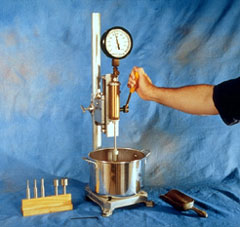Things to Consider about Hot Weather Concreting
When the temperature of freshly mixed concrete approaches approximately 77 degrees Fahrenheit adverse site conditions can impact the quality of concrete. Ambient temperatures above 90 degrees Fahrenheit and the lack of a protected environment for concrete placement and finishing (enclosed building) can contribute to difficulty in producing quality concrete.
 The use of liquid nitrogen is one option to reduce concrete’s temperature during hot-weather concreting.
The use of liquid nitrogen is one option to reduce concrete’s temperature during hot-weather concreting.
The precautions required to ensure a quality end product will vary depending on the actual conditions during concrete placement and the specific application for which the concrete will be used. In general, if the temperature at the time of concrete placement will exceed 77 degrees Fahrenheit a plan should be developed to negate the effects of high temperatures.
The precautions may include some or all of the following:
- Moisten subgrade, steel reinforcement, and form work prior to concrete placement.
- Erect temporary wind breaks to limit wind velocities and sunshades to reduce concrete surface temperatures.
- Cool aggregates and mixing water added to the concrete mixture to reduce its initial temperature. The effect of hot cement on concrete temperature is only minimal.
- Use a concrete consistency that allows rapid placement and consolidation.
- Protect the concrete surface during placement with plastic sheeting or evaporation retarders to maintain the initial moisture in the concrete mixture.
- Provide sufficient labor to minimize the time required to place and finish the concrete, as hot weather conditions substantially shorted the times to initial and final set.
- Consider fogging the area above the concrete placement to raise the relative humidity and satisfy moisture demand of the ambient air.
- Provide appropriate curing methods as soon as possible after the concrete finishing processes have been completed.
- In extreme conditions consider adjusting the time of concrete placement to take advantage of cooler temperatures, such as early morning or night time placement.
With proper planning and execution concrete can be successfully placed and finished to produce high quality durable concrete at temperatures of 95 degrees Fahrenheit or more.
Setting Time

The effect of high ambient temperatures and high temperature concrete component materials have on the setting time of concrete mixtures is a topic of concern due to the reduced time in which concrete must be placed, consolidated and finished; increased potential for plastic shrinkage cracking, thermal cracking and cold joints; potential strength reduction due to high water demand and high curing temperatures; difficulty in controlling air content; and increased urgency for applying appropriate curing method at an early age.
As a general rule of thumb an increase of 20 degrees Fahrenheit will reduce the setting time of a concrete mixture by as much as 50 percent. As an example, a concrete mixture that reaches final set in three hours at 60 degrees Fahrenheit may reach final set in as little 1½ hours at 80 degrees Fahrenheit. As the concrete temperature increases the setting time is further reduced. The actual temperature of the concrete mixture as delivered is effected by the temperature of the materials used in the mixture, the cementitious content of the mixture, the temperature of the equipment used to batch and transport the concrete, and the ambient temperature and conditions at the project site. Concrete applications may be considered hot weather concrete at temperatures ranging from 77 to 95 degrees Fahrenheit depending on the specific application. Precautions should be planned in advance to counter the effects of high temperature well in advance of execution to counter these effects.
Precautions may include use of materials with a good performance history in high temperature conditions, cool concrete materials or concrete mixture, provide concrete consistency and placement equipment and crew for rapid placement, reduce time of transport, schedule placement to limit exposure to atmospheric conditions (night time placement or more favorable weather), plan to limit rapid moisture loss (sun screens, wind screens, misting, or fogging), and consider the use of an evaporation retarder. Schedule a preconstruction meeting including all of the participants to discuss the plan to control the effects specific to the project and expected conditions.
Additional Information
"Hot Weather Concreting," Chapter 13 of Design and Control of Concrete Mixtures, EB001.15, Portland Cement Association.
ACI 305R-10, Guide to Hot Weather Concreting Hot Weather Concreting.